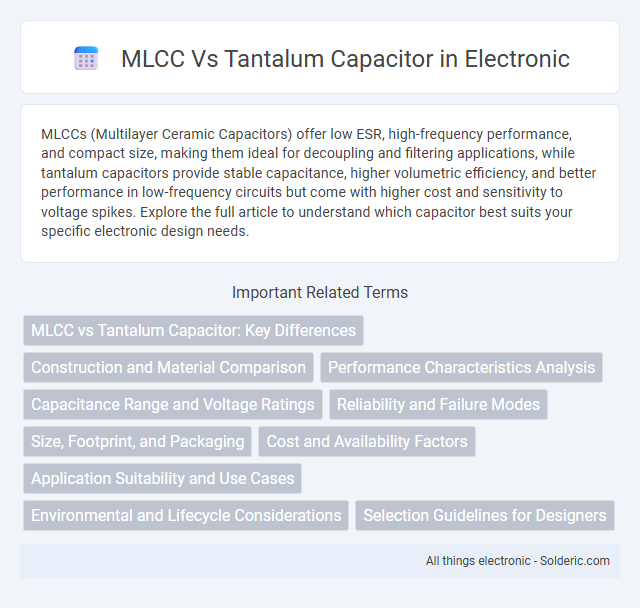MLCCs (Multilayer Ceramic Capacitors) offer low ESR, high-frequency performance, and compact size, making them ideal for decoupling and filtering applications, while tantalum capacitors provide stable capacitance, higher volumetric efficiency, and better performance in low-frequency circuits but come with higher cost and sensitivity to voltage spikes. Explore the full article to understand which capacitor best suits your specific electronic design needs.
Comparison Table
| Feature | MLCC (Multilayer Ceramic Capacitor) | Tantalum Capacitor |
|---|---|---|
| Dielectric Material | Ceramic | Tantalum Oxide |
| Capacitance Range | 1 pF to 100 uF | 0.1 uF to 470 uF |
| Voltage Rating | Up to 1 kV | Up to 50 V (typical) |
| ESR (Equivalent Series Resistance) | Low | Very Low |
| Stability | High (temperature & voltage stable) | Moderate stability |
| Size | Compact, smaller sizes available | Larger than MLCC for same capacitance |
| Failure Mode | Usually open circuit | Can fail short circuit (potential hazard) |
| Cost | Generally lower | Higher cost |
| Applications | General purpose, decoupling, filtering | Power supply filtering, bulk capacitance |
MLCC vs Tantalum Capacitor: Key Differences
MLCCs (Multilayer Ceramic Capacitors) offer higher capacitance stability, lower equivalent series resistance (ESR), and better performance at high frequencies compared to tantalum capacitors, which provide higher volumetric efficiency and better capacitance per volume. You should consider MLCCs for applications requiring low noise and high-frequency response, while tantalum capacitors excel in energy storage where size and reliability under steady conditions are crucial. Temperature and voltage derating factors also differ, with tantalum capacitors needing more conservative derating to ensure longevity in circuits.
Construction and Material Comparison
MLCCs (Multi-Layer Ceramic Capacitors) consist of multiple layers of ceramic dielectric material interleaved with metal electrodes, typically made from silver-palladium or nickel, resulting in a compact, high-capacitance design with excellent high-frequency performance. Tantalum capacitors use a sintered tantalum metal anode coated with a layer of tantalum oxide as the dielectric, combined with a wet or solid electrolyte cathode, providing higher volumetric efficiency and stable capacitance under temperature and voltage variations. Your choice depends on the desired electrical characteristics, as MLCCs offer lower ESR and better high-frequency response, while tantalum capacitors provide superior capacitance stability and reliability in demanding applications.
Performance Characteristics Analysis
MLCCs (Multilayer Ceramic Capacitors) offer high frequency performance with low Equivalent Series Resistance (ESR) and excellent stability over temperature, making them ideal for high-speed and high-frequency applications. Tantalum capacitors provide higher capacitance per volume and stable capacitance under varying temperatures but exhibit higher ESR and poorer high-frequency performance. Your choice between MLCC and tantalum should consider the specific electrical requirements, such as frequency response, capacitance, and thermal stability for optimal system performance.
Capacitance Range and Voltage Ratings
Multilayer ceramic capacitors (MLCCs) typically offer capacitance values ranging from a few picofarads up to 100 microfarads, with voltage ratings commonly between 6.3V and 100V. Tantalum capacitors provide higher capacitance values, usually from 0.1 microfarads to several hundred microfarads, and voltage ratings from 4V up to 50V, making them suitable for applications requiring stable capacitance in low-voltage environments. MLCCs excel in high-voltage and high-frequency applications, while tantalum capacitors are preferred for higher capacitance needs at lower voltages.
Reliability and Failure Modes
MLCCs offer high reliability with low failure rates due to their robust ceramic construction, making them ideal for high-frequency and high-temperature applications. Tantalum capacitors, while providing stable capacitance and better performance in low-voltage environments, are more prone to catastrophic failures from voltage spikes or reverse polarity. Understanding these failure modes ensures you select the capacitor type that maximizes your circuit's longevity and reliability under specific operating conditions.
Size, Footprint, and Packaging
MLCCs (Multi-layer Ceramic Capacitors) typically offer smaller size and footprint options compared to tantalum capacitors, making them ideal for compact electronic designs. MLCCs are available in various standardized surface-mount device (SMD) packages such as 0402, 0603, and 0805, providing greater versatility in PCB layout. Tantalum capacitors generally come in larger packages like A, B, and C case sizes, which occupy more board space and limit high-density mounting applications.
Cost and Availability Factors
MLCCs (Multilayer Ceramic Capacitors) generally offer lower cost and higher availability due to mass production and widespread use in consumer electronics. Tantalum capacitors, while more expensive, provide stable capacitance and higher volumetric efficiency but face supply constraints from limited tantalum sources. Your choice depends on budget considerations and the need for consistent supply in your applications.
Application Suitability and Use Cases
MLCCs excel in high-frequency applications and surface-mount technology due to their low equivalent series resistance (ESR) and high capacitance stability, making them ideal for decoupling and filtering in smartphones, computers, and automotive electronics. Tantalum capacitors offer higher capacitance per volume and superior performance in low-frequency, high-ripple current environments, commonly used in power supply filtering, audio equipment, and military-grade electronics. Your choice depends on the specific electrical requirements and environmental conditions of the application.
Environmental and Lifecycle Considerations
MLCCs (Multilayer Ceramic Capacitors) typically offer a longer lifecycle and higher reliability under extreme temperature conditions compared to tantalum capacitors, which are prone to wear and degradation over time due to their electrolytic nature. Environmentally, MLCCs are preferable as they do not contain heavy metals like tantalum, reducing the impact during disposal and recycling. Your choice of capacitor influences not only device performance but also environmental sustainability through better material safety and reduced electronic waste.
Selection Guidelines for Designers
When selecting between MLCC and tantalum capacitors, designers must consider factors like capacitance value, voltage rating, and reliability under varying thermal conditions. MLCCs offer low equivalent series resistance (ESR) and high-frequency performance suitable for decoupling and filtering, while tantalum capacitors provide higher capacitance per volume and stable electrical characteristics for bulk storage in power supply circuits. Your design decision should balance cost, size constraints, and anticipated electrical stress to optimize overall circuit efficiency and lifespan.
MLCC vs tantalum capacitor Infographic

 solderic.com
solderic.com